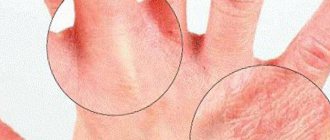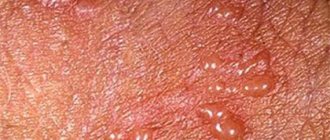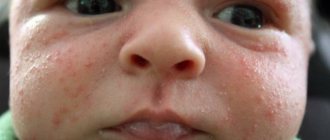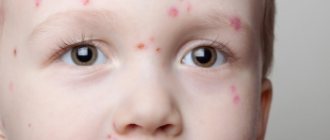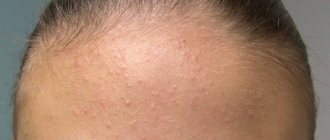All organs in the human body are closely interconnected. As soon as one organ fails, the entire system fails. One of the clearest indicators that deviations from the norm are occurring in the body are pimples on the tongue closer to the larynx. Under normal circumstances, the tongue is slightly rough, pink in color, without white coating, bumps or pimples. But what does the body want to tell us if pimples appear on the tongue closer to the throat? We will try to understand this in detail in our article.
What is this problem?
Red pimples and pimples on the tongue are formed due to enlargement of the papillae.
Hypertrophy and redness of the latter occurs as a result of tissue desquamation. If the mucous membrane of the tongue is covered with plaque and red pimples, then you should not put off visiting a doctor, otherwise the problem may become serious.
The first step is to find out in which area the pimple has formed, because the tongue is a suitable place for the growth of most bacteria.
In order to visually detect the inflamed area, the simplest method is suitable: carefully examine this muscular organ for the appearance of red pimples.
Several foci of inflammation can be detected at once, for example, red or white pimples may appear on the surface of the tongue, and each of them has its own cause and etiology.
Types of inflammation
On the organ of speech you can find different types of inflammation (acne):
- red pimples;
- white pimples;
- whitish pimples, often found on the walls of the throat and pharynx.
Blisters on the root due to allergies
Self-examination of the speech organ will help to visually determine the following characterological features:
- pimple color, changes in coloration;
- shape of the neoplasm (round, oval);
- features of the surface of neoplasms (lumpy, smooth, convex).
Detection of spots, pimples and other growths during self-diagnosis and in the presence of discomfort is a sufficient indication for consultation with a specialist.
Self-examination helps differentiate acne based on the organ of speech from scratches and minor injuries caused by microtrauma during eating, using abrasive toothpastes and powders, or a toothbrush with stiff bristles.
Where are red pimples on the tongue located?
The following options for acne location are possible:
- The pimple affects the tip. The reasons for the formation are varied; many factors provoke the appearance of red pimples in this area.
- Pimples on the tongue closer to the throat. Red rashes, as a rule, are located closer to the base of the throat and the root of the tongue; they are almost impossible to see without an additional light source.
- Red pimples may appear on the tongue on the inside, as well as on the side of the frenulum. Acne covers different lower zones, but such a clinical manifestation occurs in rare cases.
Herpangina
Another name for this disease is herpangina or enteroviral vesicular pharyngitis. The disease occurs due to infection by enteroviruses, most often the Coxsackie virus. The disease is called herpetic sore throat because of the similarity of pimples with rashes that appear when affected by the herpes virus of the first and second types.
Herpangina affects the palatine arches, soft palate and the posterior wall of the oropharynx. The mucous membrane suffers from numerous small pimples; they are blisters with clear liquid. Some time after the onset of the disease, the pimples break out and the contents pour out. The disease is extremely contagious and is transmitted by airborne droplets.
Herpetic sore throat is manifested by the following symptoms:
- Abrupt onset with high body temperature.
- Severe sore throat leads to difficulty swallowing.
- Gastrointestinal disorders may occur: abdominal pain, nausea and vomiting.
- Swelling in the nose leads to congestion and difficulty breathing through the nose.
- Pimple-like rashes in the pharynx and throat area.
Photos and videos will help you understand the difference between herpetic sore throat and herpes of the first and second types.
We suggest you familiarize yourself with how long and how long Ketorol tablets and ampoules last after use
Causes and symptoms of pathology
Pimples are most often localized on organs such as:
- uvula;
- tonsils;
- back of the throat;
- language;
- pharynx.
Red pimples
Aphthous stomatitis
The disease can be triggered by the use of toothpaste containing sodium lauryl sulfate.
It is characterized by damage to the mucous membranes of the mouth and throat, which causes aphthae - superficial ulcerations. The main causes of the disease are poor oral hygiene, injuries, poor diet, lack of vitamins, bad habits, and tumors in the nasopharynx. More often the disease is diagnosed in children. Pimples on the throat of a whitish hue, surrounded by a bright red halo, are visualized. Symptoms:
A doctor can determine the cause of the formations.
increase in temperature (in children - up to high levels);- swelling;
- painful to swallow;
- redness of the throat;
- enlarged lymph nodes in some cases.
Glossitis (inflammation of the tongue)
This disease causes red pimples on the tongue. Since the disease has a viral-bacterial etiology, the infection spreads to the mucous membrane of the throat. The disease occurs due to injuries and burns of the tongue, bad habits, and consumption of too hot foods and drinks. This contributes to the formation of microcracks where infection penetrates. Symptoms:
- burning, swelling, redness;
- loss of taste;
- pimples on the root of the tongue or blisters that open and cause erosion;
- sore throat;
- difficulty swallowing.
Granular pharyngitis
The diagnosis is made if red pimples appear on the back of the throat. The disease is preceded by factors such as hormonal disorders, deterioration of the digestive system, inflammation of the nasopharynx, and a decrease in local immunity due to acute respiratory viral infections. Signs of pharyngitis:
- dryness, foreign body sensation and sore throat;
- cough;
- there is no elevated temperature.
Scarlet fever
Symptoms of scarlet fever.
The disease occurs in both children and adults. The causative agent of the disease is considered to be hemolytic streptococcus. Infection occurs through contact with a sick person, as well as through the use of his clothes and utensils that have not been disinfected. A rash appears on the tongue - small red dots. A pimple may form on the tonsil, since the disease often accompanies a sore throat. Manifestations:
- hyperthermia;
- headache;
- profuse rashes, especially in the area of the elbows and knees, on the face, groin;
- heart rhythm disturbance;
- unnatural blush on the cheeks;
- swelling, redness of the tonsils, as with a sore throat;
- peeling of the skin after the rash subsides.
White pimples
Sore throat (tonsillitis)
This disease causes yellow or white pimples on the tonsils, as well as plaque or plugs. The disease is provoked by bacteria and viruses - streptococci, staphylococci, adenoviruses, Coxsackie or herpes viruses, yeast fungi. Microbes are activated and multiply due to decreased immunity, prolonged exposure to cold, throat trauma, as well as due to inflammatory processes in the mouth, deterioration or absence of nasal breathing. Symptoms:
- temperature rise to 39-40 degrees;
- severe sore throat;
- enlarged lymph nodes;
- redness on the palate, tonsils and uvula;
- swelling;
- muscle and joint pain;
- lack of appetite;
- weakness, general malaise.
Throat abscess
Pathology occurs in the pharynx and larynx. It appears as white pimples in the throat filled with purulent exudate. Most often, unilateral localization is observed. The disease is provoked by pathogenic pyogenic microorganisms - staphylococci, streptococci, Proteus, E. coli. In adults and children, the disease appears as a result of trauma to the pharynx, after tonsillitis, hypothermia, decreased immunity, chronic infections on the palatine arches or on the small uvula. Signs:
Another disease is accompanied by large white pimples - throat abscess.
the throat hurts, when swallowing the pain radiates to the ear;- hyperthermia;
- difficulty swallowing;
- tonic spasm of the jaw muscles;
- enlarged lymph nodes;
- the appearance of nasality in the voice;
- bad breath;
- general deterioration of condition.
Herpetic infection
The disease is caused by herpesvirus type 1. Infection occurs through contact with a sick person, casual sexual intercourse, or through airborne droplets. The disease manifests itself after hypothermia, frequent colds, the formation of microcracks in the oral cavity, and meningitis. Pimples on the back of the throat and other parts of the mouth are white or clear. In addition to the fact that the patient has joint pain, the following manifestations are also present:
- poorly controlled hyperthermia;
- the formation of white scars after opening acne;
- general deterioration of health.
Granular pharyngitis
Granular (hypertrophied) pharyngitis is a chronic disease of the pharyngeal mucosa. A chronic disease develops from an advanced acute condition.
Pimples with granulosa pharyngitis always form on the back wall of the throat. The lack of competent and timely treatment provokes frequent relapses of chronic diseases of the throat mucosa.
Granular pharyngitis can be an independent disease in the following cases:
- if there is a fact of a decrease in the protective mechanisms of the pharyngeal mucosa - a consequence of acute respiratory infections, acute respiratory viral infections, tonsillitis or surgical intervention;
- damage to the mucous membrane of the throat by contrast agents - cold food, drinks, air, hot drinks and food, spicy food, smoking.
The disease can also manifest itself in a complex of symptoms of an acute illness:
- diseases of the digestive tract;
- taking medications that cause dry throat;
- endocrine diseases;
- problems with nasal breathing, formations in the nasopharynx and the presence of inflammatory processes;
- allergic reactions.
A patient with granulosa pharyngitis presents the following complaints:
- Feeling of dryness and sore throat. Unpleasant sensations intensify with strain on the throat - a long conversation.
- Some patients complain of ear congestion, which disappears when swallowing.
- With granulosa pharyngitis, there is a feeling as if something is stuck in the throat.
- There is a desire to cough. If it intensifies at night, it can interfere with proper sleep.
- On the back wall of the throat, red pimples or bumps with a glossy sheen are clearly visible.
- Body temperature does not increase with this disease.
Important: the disease is often asymptomatic, when a person does not feel any problems, there are no complaints, and upon examination, pimples are visualized on the back of the throat.
Candidiasis
Pimples on the back of the throat can be the result of taking various medications. For example, hormonal drugs for the treatment of bronchospasm provoke candidiasis, otherwise known as oral thrush.
Inhaled hormonal drugs inhibit the protective mechanisms of the oral mucosa, disrupting the balance of the local microflora. Fungi of the genus Candida, which normally live on most mucous membranes, begin to multiply intensively, affecting tissues.
The first symptoms are the appearance of small pimples on the hard palate. They are quite difficult to feel, but upon visual inspection they are easily distinguishable - they are very small in size, large in number and white in color.
If the disease develops, the next symptom is a sore throat and minor pain. Complaints regarding the throat are explained by the formation of pimples on the back of the throat; they can provoke a cough, increased pain and rawness in the throat. Further, a whitish coating may appear on all mucous membranes of the mouth and oropharynx.
The disease occurs without an increase in body temperature.
Important: if not stopped in time, it can cause very unpleasant sensations in the oral cavity.
Diagnosis of the disease
In addition to the treating pediatrician, a gastroenterologist, dentist, ENT doctor, or infectious disease specialist can clarify the diagnosis when a rash appears on a child’s tongue.
To clarify the diagnosis, they use the following methods:
- visual examination of the mucous membrane of a small patient’s tongue;
At the appointment, the pediatrician always looks at the child’s tongue
- taking anamnesis;
- conducting analytical studies: this is a detailed biochemical blood test, allergen tests, urine analysis, coprogram;
- examination of a smear from the mucous membrane of the mouth and tongue.
READ ALSO: 16 ointments for boils that draw out pus at the initial and late stages of chiria
Classification of diseases that contribute to the appearance of acne
Pimples on the tongue appear under the influence of a number of factors, which include diseases and the process of microtraumatization of the mucous membrane of the tongue.
Microtraumatization is a process of permanent damage to the mucous membrane of the speech organ, which is carried out:
- cutlery (during meals);
- sharp edges of teeth (in case of malocclusion);
- braces (if installed incorrectly);
- hard bristles of oral hygiene products (brushes).
Root organ cancer
Among the pathologies that cause the appearance of pimples closer to the throat, the following diseases are distinguished:
- glossitis;
- stomatitis;
- candidiasis;
- angina;
- scarlet fever.
A cyst on the root is a benign neoplasm
What to do if a rash appears in your child’s mouth
To determine an accurate diagnosis and prescribe adequate treatment for children under one year of age when a rash and accompanying symptoms appear, it is necessary to contact their attending pediatrician.
Doctors prescribe the following medications as local antiseptics and antimicrobials:
- Rotokan solution as a lotion;
Rotokan solution is used to get rid of rashes on the tongue
- antimicrobial “Miramistin” (0.01% solution) for wiping the tongue and rinsing the mouth;
- Chlorophyllipt (herbal preparation);
- Chlorhexidine bigluconate to fight bacteria, fungus, chlamydia;
- 0.05% Chlorhexidine solution.
Important ! It should not be used in children under 36 months.
To alleviate the condition of rashes on the tongue, especially with itching, you can resort to traditional medicine recipes: these are decoctions of oak bark, tinctures of calendula, chamomile or sage. As a rule, they are all hypoallergenic and quite effective.
Advice. It is recommended to rinse the mouth several times a day with antiseptic solutions.
Regular and purulent sore throat
The appearance of pimples on the tongue closer to the throat is often associated with tonsillitis - an acute, contagious (infectious) disease that affects the lymphoid tissue of the tonsils. Sore throat contributes to a sharp deterioration in the functioning of the immune system and weakens the body.
Tonsillitis in the throat
The causes of sore throat are microorganisms of streptococcal and staphylococcal nature. Symptoms of sore throat are presented as:
- enlarged lymph nodes;
- the appearance of rashes (pimples) on the mucous membrane of the oral cavity (tongue, palatal area, back of the throat);
- formation of mini-abscesses on the back wall of the pharynx;
- general weakness;
- development of swelling of the tonsils, their soreness;
- a sharp increase in body temperature to hectic (high) numbers: 38.8-39.0˚; loss of appetite.
Treatment of angina involves:
- antibiotic therapy (depending on the doctor’s prescription);
- antiseptic therapy (sanitation of the source of infection - inflamed tonsils
- antiseptic solutions); sanitation includes: rinsing with furatsilin solution, treating the tonsils with Lugol's solution, irrigation with anti-inflammatory sprays;
- complex vitamin therapy;
- increased immunity (due to taking echinacea tincture).
Lugol's throat solution
How to treat?
Drug treatment
If you have a sore throat, an antipyretic is first prescribed.
A doctor should treat pimples in the throat; self-medication is prohibited. Depending on the etiology of the disease, antibiotics or antiviral drugs are prescribed. At high temperatures, it is recommended to take antipyretics. Abscesses can be cured with surgery. In general, therapy includes the medications shown in the table:
| Medication group | Name |
| Antibiotics | "Ampicillin" |
| "Erythromycin" | |
| "Clarithromycin" | |
| "Amoxiclav" | |
| "Azithromycin" | |
| "Cefuroxime" | |
| Antiviral | "Groprinosin" |
| "Amizon" | |
| "Amiksin" | |
| "Remantadine" | |
| Antiherpes | "Zovirax" |
| "Acyclovir" | |
| "Famvir" | |
| "Valacyclovir" | |
| Throat antiseptics | "Septefril" |
| "Chlorophyllipt" | |
| "Angilex" | |
| "Stopangin" | |
| "Inhalipt" |
Treatment with traditional methods
At home, you can gargle with a decoction of antiseptic herbs - chamomile, eucalyptus, oak bark, St. John's wort, sage. Recipe:
- Take 1 tsp. plants and pour a glass of boiling water.
- Let it brew, cool, filter.
- Rinse 4-5 r. per day.
If your throat hurts, you can make warm compresses from boiled potatoes. To do this, grind the vegetable into a puree and add vodka. Place the mixture on a cloth, wrap it around your neck, tying it with polyethylene and a warm scarf on top. Inhalations with essential oils of tea tree, bergamot, and lavender are recommended. It is effective to suck on a piece of propolis or eat a spoonful of honey without drinking water.
Consequences of upper respiratory tract diseases
Pimples on the back of the throat can be a consequence of recent illnesses:
In this case, pimples are a collection of lymphatic tissue. Their appearance is normal after illness. In this situation, acne on the back wall persists and increases in size for a month after the end of the disease.
However, in some situations you should contact a specialist:
- if the pimples on the back of the throat have not disappeared at the end of the month;
- if there is a sore throat and a desire to cough;
- if colds and upper respiratory tract diseases occur frequently, and the recovery process is delayed.
We invite you to familiarize yourself with Red bumps on the tongue
Important: if a child suffers from chickenpox, pimples may appear on the back of the throat, because the disease affects not only the skin, but also the mucous membranes.
Pimples in the throat with chickenpox appear in both adults and children
What other diseases can cause the appearance of red spots on the palate in children and adults?
If red spots appear on the palate of yourself or your child, be sure to consult a doctor.
A person can encounter the problem of redness of the palate only once during his life or periodically, which is due to the nature of the disease that has these symptoms. Relapses include herpes, thrush, and enterovirus infections.
Once the body has been affected, it is impossible to get rid of them. When conditions are favorable for viruses and bacteria, the disease worsens, so it is important to take preventive measures to suppress the pathogen.
The characteristic red rash in the mouth is one of the symptoms of other diseases.
- of tuberculosis is flat red spots on the oral mucosa. Over time, the reddish or red-yellow inclusions merge to form plaques. The surface of the formations is heterogeneous, the color becomes red-bloody.
- ARVI is recognized in particular by red spots on the soft palate and tongue. Associated symptoms are characteristic of acute respiratory diseases.
- Oncology, among a large number of signs, has one more, which is related to the oral mucosa. A small ulcer forms on the palate, increasing in size over time. However, at first it does not cause discomfort, there are no painful sensations. Reaching large volumes, the ulcer begins to interfere, and difficulty is experienced when swallowing.
- Vitamin deficiency is characterized by a deficiency of vitamins and minerals important for all body systems. Their deficiency weakens protective functions and increases vulnerability to bacteria, fungi, viruses and infections. Red spots with vitamin deficiency are located locally on the skin and mucous membranes, without spreading intensively to neighboring areas.
- Herpes is a viral infection that once it enters the body, does not disappear. The disease worsens against the background of weakened immunity. A characteristic sign: small red spots on the mucous membrane, increasing in size, transforming into small bubbles with liquid inside.
- Chickenpox is diagnosed mainly in children under 14 years of age, but this does not exclude the risk of infection in adults. Not only the skin, but also the mucous membranes are covered with spots. In the mouth you can first find small red dots, which turn into bubbles and very soon burst. This results in gray or yellow ulcers with redness around the circumference.
- Measles is characterized by a rash on the skin and mucous membranes, high fever, general physical weakness, and lack of appetite. The affected area even extends to the mucous membrane of the eyes. Initially, white spots form in the mouth behind the cheeks, and as it moves to other areas, the rash acquires a bright red tint.
- Infectious mononucleosis is recognized by its extensive affected area; spots cover not only the palate, but the entire oral mucosa. There is a soreness in the larynx, and the tonsils increase in size. Breathing becomes difficult due to nasal congestion. Characteristics of the spots: the color is bright, the parameters are impressive, they appear more often along the palate, and quickly spread to other areas.
- Scarlet fever is recognized by red spots that are localized on the soft palate. Other signs of the disease: headache, fever, nausea, pain when swallowing. The tongue becomes crimson in color, the mucous membrane is inflamed, and the rash on the skin is very itchy.
The appearance of pimples on the organ of speech as heralds of candidiasis
Candidiasis is a disease characterized by the development of a fungal infection in the body; the causes of the development of the disease are associated with constant disturbances in the functioning of the immune system. The root of the accompanying problems lies in the presence of weak immunity, the formation of which is impaired for a number of reasons:
- early illnesses with a severe course;
- carrying out surgical interventions (against the background of reduced immunity);
- the presence of severe pathologies of the immune system (HIV infection, due to constant suppression of the immune system).
Candidiasis and blisters on the root
Visually, candidiasis is represented by a white coating on the tongue, the appearance of white pimples on the mucous membrane of the mouth and tongue closer to the throat, the back wall of the pharynx. The localization of pimples depends on the severity of the disease; the weaker the immune system, the stronger the damage to the mucous membrane - a fungal infection.
Complex therapy for candidiasis involves:
- use of drug therapy (antifungal drugs: nystatin, levorin);
- applications with decamine ointment;
- treatment of the mucous membrane with solutions - fucorcin, methylene blue;
- rinsing with boric acid solution.
- improving the functioning of the immune system;
- complex vitamin therapy;
- hardening procedures (after recovery);
regular physical activity (to strengthen the immune system).
Causes of red pimples and pimples on the tongue
A thorough visual examination of the inflamed organ is necessary in order to make an accurate diagnosis and conclude that the redness was caused by a pimple. It should be clarified that the occurrence of painful sensations is not associated with mechanical damage received during eating. You should also make sure that there is no stomatitis, fungal or other infectious diseases of the oral cavity that affect the tongue.
When the papillae on the tongue become inflamed, they increase in size and become red, and they become painful, especially when touched or exposed to food. Popularly, such pimples are called “pipun”. Causes of inflammation:
- Chemical burn due to exposure of aggressive acids or concentrated alkalis to the oral cavity.
- Chemical trauma that a person receives when dissolving certain tablets. The risk of chemical injury due to the tablet form of medications increases if the dose exceeds the recommended limit.
- Thermal burns caused by hot drinks or hot dishes.
- Puncture or cut by bone
- Injury to tongue tissue by dentures.
It is important to reduce the inflammatory process as quickly as possible and stimulate regenerative mechanisms in the tissues of the affected organ. To exclude the presence of an infectious agent as the culprit in the appearance of a red pimple, scraping is required. With its help, a medical professional identifies a pathogenic microorganism, which subsequently makes it possible to prescribe adequate treatment.
There are many reasons for the appearance of red rashes on the tongue:
- Allergic reaction. The allergic nature of the pathology gives a signal about the presence of allergens in oral hygiene products: toothpaste, brush, mouthwash. Allergies can get worse when you eat certain foods.
- Red or white pimples are one of the obvious symptoms of stomatitis. The mucous membrane of the mouth becomes inflamed under the influence of viruses and bacteria. The classification of stomatitis is based on the causative agent of the disease. If stomatitis appears due to non-compliance with hygiene rules, then it will not be difficult to cure it. For this purpose, antibacterial drugs are actively used to sanitize the oral cavity. The help of a dentist is required when the number of inflamed acne increases rapidly.
- Vitamin deficiency. Vitamin deficiencies are a common cause of tongue problems. Lack of B vitamins and folic acid in the body has a detrimental effect. The taste buds turn bright red.
- Granular pharyngitis. Pimples are found on the tongue closer to the throat. The disease is characterized by chronic inflammation of the mucous membranes of the larynx. The back of the throat becomes covered with red blisters, sometimes moving to the tongue. Pharyngitis often occurs after a cold or sore throat.
- Immunosuppressive conditions.
- Digestive problems and dysbiosis, marked by disruption of intestinal microflora and poor absorption of nutrients. For this reason, pimples may appear on the base of the tongue.
- Glossitis. The disease does not affect the mucous membrane of the mouth, only the tongue becomes inflamed. Often occurs due to trauma to the tongue by a tooth or denture. A deviation can develop in the absence of proper oral care due to bad habits. Glossitis can appear against the background of problems with the gastrointestinal tract, anemia and a number of infectious diseases. A mild form of the pathology is characterized by symptoms of stomatitis, that is, red blisters are noticeable on the tongue. The deep form is complicated by ulcers and phlegmon.
- Thrush. Infection of the oral cavity by fungi is called candidiasis. The disease makes itself felt when a person’s immune functions are weakened or a disruption occurs in the functioning of organ systems. Along with increased dryness of the mouth and throat, pimples may appear on the tongue.
- Impetigo. The streptococcal infection penetrates the root of the tongue and causes the formation of superficial blisters containing clear fluid.
- Pyogenic granuloma. In rare episodes, it manifests itself on the tongue in the form of red nodules consisting of blood vessels in the area where there used to be a wound.
- Exudative erythema. The patient complains of red spots and blisters over the entire surface of the tongue. Once ruptured, the blisters leave long-healing ulcers. The reason lies in pathogenic microbes.
- Scarlet fever. It is characterized by inflammation of the entire oral cavity, red pimples affect the tonsils and appear on the tongue.
We invite you to read everything about installing veneers - how to install veneers
Causes of rashes on the tongue
The reasons why pimples appear on the tongue can be different. Here are the most common factors that cause this misfortune:
- mechanical damage, chemical or thermal burns;
- allergic reactions;
- infection, penetration of bacteria;
- taking antibiotics, disruption of intestinal microflora as a result of various diseases;
- smoking;
- use of low-quality oral care products;
- decreased immunity.
In addition, the cause of rashes on the tongue (especially on the tip) may be a common irritant - for example, acid contained in fresh fruits, vegetables, juices, etc.
Types of acne and their characteristics
Depending on the appearance of the pimple and the symptoms that accompany the tumor on the tongue, you can more accurately determine its type, and therefore the further method of treatment.
- Glossitis
This inflammatory disease is characterized by the appearance of numerous red, flat spots. The tongue hurts and swells. When neglected, such formations on the tongue turn into mushroom-like growths and occupy a fairly large area. The sense of taste is dulled, food is not enjoyable, and salivation increases. There is an unpleasant odor coming from the mouth.
If rashes on the tongue are the result of glossitis, it is very important to find out exactly why this disease appeared. After all, glossitis is often a secondary sign of serious diseases of various organs and systems, for example, the gastrointestinal tract, respiratory system, and blood flow.
- Stomatitis
With stomatitis, the uvula is covered with small white pimples, which are very painful and interfere with eating, and sometimes even swallowing saliva. A characteristic feature of stomatitis is that pimples cover not only the tip and middle of the tongue, but are also localized on the frenulum, the inner surface of the cheeks, and gums. Most often, this disease affects young children, who are known to constantly put their fingers, toys, and eat unwashed fruits in their mouths.
- Allergic reaction
In case of allergic reactions, red pimples can be localized anywhere - under the uvula, on the tip, on the palate. As a rule, such rashes on the tongue are characterized by severe itching and cause discomfort.
Sometimes small white or red formations on the surface and under the uvula are not pimples at all, but are inflamed cells. Our tongue, as you know, is dotted with many papillae - receptors responsible for the perception of taste and temperature.
They can become inflamed due to an external irritant - spicy or sour foods, drinks, traumatic foods (seeds, chips, crackers). Most often, inflammation of the papillae is localized at the tip - small red pimples appear there, which turn white over time - this indicates that the cells of the papilla are dying. As a rule, such rashes are single and do not cover the entire tongue.
Causes of pimples in the throat
A healthy throat should be pale pink in color, without any peculiarities in the condition of the mucous membrane. When problems appear on the delicate skin of the throat, it is immediately noticeable even to an ordinary person.
Pimples on the back of the throat are not a rare complaint from patients. Some people discover these symptoms by accident, because they can be present without causing any sensation.
Other patients feel the pimples and the discomfort they bring. They can appear in various situations. Next, the main reasons for the appearance of such acne will be discussed.
Self-diagnosis of tumors on the tongue
Pimples on the tongue are one of the first signs of a disease in the body that occurs in a latent (hidden) form. The disease begins to make itself known gradually or suddenly, depending on the nature of the pathology, its location and severity. The speed of development of the first signs of pathology indicates its aggressiveness and the strength of its negative impact on other organs and systems of the body.
Self-diagnosis of the tongue is the right step towards maintaining the health of the body, the possibility of early detection and treatment of pathology.
This procedure can be performed in the morning, in front of a mirror, if:
- pain;
- unpleasant sensations: itching, burning;
- swelling and swelling of the speech organ.
Self-examination - accessible self-diagnosis
Self-examination is a simple procedure that does not require outside intervention. Standing in front of a mirror, you need to open your mouth wide and stick out your tongue so that you can carefully examine it. The localization of pimples on the tongue is varied, they are located:
- based on language;
- pimples on the root of the tongue closer to the throat;
- pimples on the root of the tongue - much more common than pimples at the base of the tongue;
- on the side surfaces;
- in the sublingual area.
Self-diagnosis allows you to identify not only the location, but also the type of tumor.
What types of pimples can be found on the tongue?
The first thing you should do if you experience discomfort in the oral cavity is to conduct a detailed self-examination. By picking up a mirror, you can determine the shape, color and location of the formations. There are two types of pimples you can see in your mouth:
- Red pimples are lumpy and can be very painful and burn. Often with this type of pimples, taste differences disappear.
- White pimples can be located all over the tongue or at its base. Pimples can be covered with a cheesy coating or be very painful, depending on the ailment that caused them.
Stomatitis and its effect on the mucous membrane of the tongue
The inflammatory process of the oral mucosa also causes pimples to appear on the tongue. The causes of stomatitis and glossitis are similar, but stomatitis more often occurs due to poor oral hygiene.
Stomatitis in the mouth - thrush
The main reasons for the formation of stomatitis:
- lack of oral hygiene (insufficient hygiene);
- presence of bad habits;
- exposure to stress;
- the presence of “aggressive” food products in the diet: pickles, smoked meats;
- the body's susceptibility to frequent colds;
- microtraumatization of the mucous membrane.
Stomatitis causes the appearance of white pimples on the mucous membrane of the tongue and oral cavity. Pimples often appear on the tongue closer to the throat, due to the addition of inflammatory processes in the nasopharynx (sore throat, pharyngitis). Pimples are characterized by:
- soreness;
- causing inconvenience while eating.
Herpes stomatitis - bright red burning spots
Therapeutic and preventive measures to eliminate and prevent stomatitis:
- constant oral hygiene;
- antiseptic treatment (rinsing, treatment with antiseptic solutions);
- inclusion of vitamin A in therapy (promoting rapid healing of damaged tissue).
Probable Causes
Due to weak and undeveloped immunity in children, almost all pathogenic microbes and bacteria begin to multiply intensively. One of the consequences of their influence is a rash on the child’s tongue. These rashes come in different types:
- serous fluid in blisters;
- dense, irregularly shaped blisters that can cause itching;
- pustular type of different depths with cloudy contents;
- spots of varying degrees and types of color (usually scarlet or red, can be white);
- ulcers affecting the mucous membrane;
- plaques, sometimes merging in several pieces;
- keratinized areas.
The most common causes of various rashes in the oral cavity in children are the following.
Stomatitis
The rash, caused by harmful microbes carried into the mouth by dirty hands, appears at the base of the tongue, consists of small pimples, colored bright red or pink, and is accompanied by bad breath. It causes pain and burning sensation when eating.
Rubella
The rash starts from the face and neck, then covers the entire body, including the oral mucosa (single pimples). They are round or elongated in shape, do not merge with each other, and are colored pale red.
Scarlet fever
This is a very dangerous infectious disease caused by streptococcus, which is fraught with serious complications on the heart, kidneys, as well as rheumatism and pneumonia. The name of the disease (translated as “scarlet”) emphasizes the bright color of the rash that covers the body and the mucous membranes of the throat and tongue.
READ ALSO: Pimples and rashes after a massage: why do they appear, is treatment necessary?
Additional Information. The scarlet color of scarlet rashes is explained by blood vessels bursting from the effects of the toxin.
The intensity of shedding increases gradually, up to a maximum on days 3-5. After which the rash begins to turn pale, peeling and peeling of the skin in the affected areas.
Pseudotuberculosis
Small dots may appear on the child's crimson tongue in case of Far Eastern scarlet-like fever (or pseudotuberculosis); the rash appears from 2 to 4 days of illness. Initially, the tongue is covered with a thick white coating. The disease is accompanied by severe intoxication and causes complications in the joints and liver.
Stevens Jones syndrome
The infectious disease is potentially life-threatening. Thin-walled blisters with serrous fluid sprinkle the lips, mucous membranes of the cheeks and tongue. After opening, they form erosive, very painful wound surfaces. The tongue swells greatly, the lips become covered with necrotic crusts. In severe cases, blisters in the mouth prevent patients from eating and talking.
Chickenpox
An infectious disease, literally transmitted through the air, characterized by the formation of papules in the mouth, throat and under the tongue. Pimples are red in color. Each small chickenpox blister has liquid inside; after it bursts, weeping wounds are formed, causing pain for the baby when eating, they can also pinch and itch.
The rash associated with chickenpox is called vesicles and occurs not only on the tongue, but also on the gums and lips on the inside.
Other pathologies
A rash on a child’s tongue appears due to diseases such as:
- Viral pemphigus, caused by an enterovirus, children can become infected with it through airborne droplets;
Note ! Rashes may appear on the delicate baby skin of the butt and arms.
- Candidiasis (or thrush) is a fungal infection of the Candida genus; the baby can catch it from the mother, especially with a weakened immune system; treatment consists mainly of treating the baby’s oral cavity with soda solution;
- Allergy – manifestations in the form of itchy and not very rashes upon contact with an allergen;
- Measles - a rash in the form of small white spots, similar to semolina grains, appears on the mucous membrane of the cheeks, soft and hard palate, as well as the tongue. The famous pediatrician Komarovsky believes that measles is dangerous for young children with complications such as pneumonia, eye diseases, even blindness, encephalitis, and poor blood clotting.
READ ALSO: Water rash - Rashes (rashes)
Follicular tonsillitis
This is a bacterial type of acute inflammation of the pharyngeal tonsils. The main causative agents of the disease are streptococcus, staphylococcus and pneumococcus. The main symptom of follicular tonsillitis is the presence of follicles on the palatine tonsils, which are nothing more than lymph nodes.
Upon visual inspection, they take different forms:
With an extensive inflammatory process, not only the palatine tonsils suffer, but also the nasopharyngeal tonsil and the posterior wall of the head. It exhibits the same symptoms that can be observed on the tonsils. More often, with the follicular type of sore throat, white pimples and pustules the size of a pinhead are observed on the back surface of the oropharynx.
The onset of follicular tonsillitis can be understood by the symptoms:
- Abrupt onset of the disease. The first complaint is a severe and sudden headache. Elevated temperature and increasing intoxication.
- The second complaint is acute pain in the throat, which gets worse when swallowing.
- Hyperemia of the mucous membrane, enlarged tonsils with inflammatory foci are visualized. Pustules and white pimples can be seen on the tonsils and on the back of the throat.
Follicular type sore throat is the most common cause of pimples in the throat


